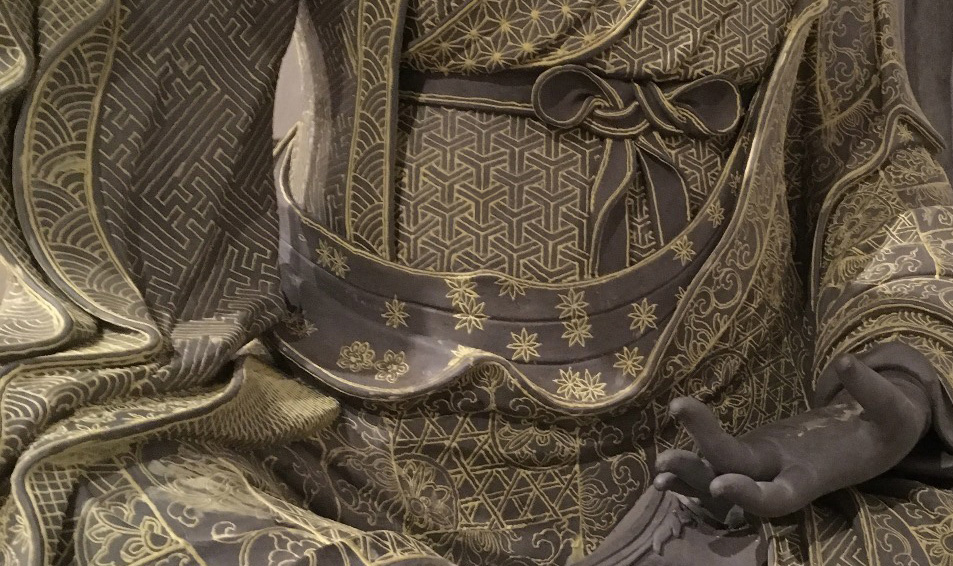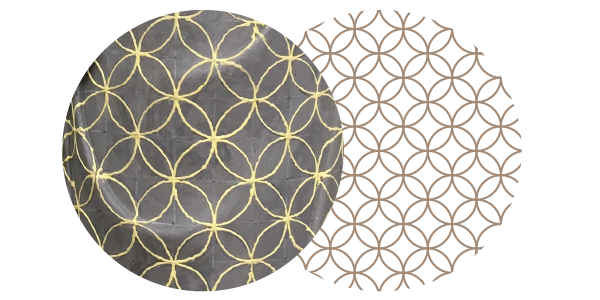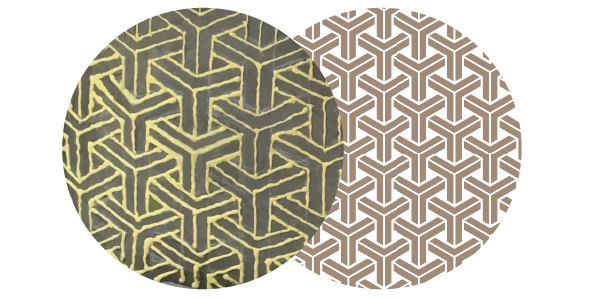Japanese Patterns

Background Information
Buddha Pāda Institute took 14 years to complete; the labor of love of Nyichang Rinpoche’s students, Kelsang Bhutia from Tibet and Hideaki Inomoto from Japan. It has been designed by architect Yasuda Kenji who lives and works in Osaka, Japan. Nyichang Rinpoche’s aspiration and Yasuda Kenji’s dream was realised by Rinpoche’s devoted student, Hideaki Inomoto, who worked tirelessly as an embodiment of the teacher’s heart-mind and the architect’s eyes.
Guru Rinpoche and Avalokiteshvara wearing Japanese patterns
The robes of Guru Rinpoche and Avalokiteshvara are decorated with ancient Japanese patterns. Each Japanese pattern contains a prayer for good luck, happiness and fertility. We pray that peace will be realised in this region and eventually the world. These patterns also symbolize the deep connection between the Buddhist culture of India and the Himalayas and that of Japan in the future. The work was designed and guided by Japanese Buddhist artist, Kijima of Taikondo and executed by Jigdel, an artist from Bhutan.

Asanoha 麻の葉
Since ancient times, the Asanoha pattern has been used in holy rituals. It is a familiar design and is often used for baby clothing as it is believed to bestow good health and long life. The Asanoha is found on the clothing of Buddhist statuary of the Heian through Muromachi periods. The triangle denotes protection against evil, and Asanoha, an aggregate of triangles, conveys the meaning of strength and beauty.

Shippo 七宝
Shippo, or the ‘seven treasures’, as mentioned in the Buddhist scriptures, refers to gold, silver, lapis lazuli, crystal, agate, red coral, and carnelian. Circles overlapping in quarters resemble petals and each center forms a shining star. The pattern is regarded as auspicious for the prosperity of descendants, good relationships, and for bringing harmony.

Seigaiha 青海波
This pattern brings to us thoughts of large waves of the wild ocean. The continuing gentle waves laid out in a regular pattern include the wish, “Let this life forever rest in peace and happiness.” This wave crest pattern is traditionally named as ‘Kissho’ pattern or ‘auspicious omens’ pattern.

Manji-Kuzushi 卍崩し
Manji-kuzushi (Manji-tsunagi/Sayagata)
The manji (Sanskrit: svastika) is a symbol of virtue appearing on the chest, hands, and feet of the Buddha. It is said to indicate the characteristics of a great person and came to mean a collection of virtues representing auspiciousness and good fortune. In Japan, the svastika is found on Buddhist statues from the 8th century on. Designs based on the svastika known as manji-kuzushi, manji-tsunagi or sayagata were introduced from Ming Dynasty China to Japan in the 16th century (Momoyama era) and were used on material for kimonos, etc. Such patterns are believed to signify family prosperity and longevity.

Bishamon-Kikko 毘沙門亀甲
The Bishamon-kikkō (“Vaiśravaṇa tortoise shell”) pattern is so named because it is used on the clothing and armor of Bishamon-ten (Sanskrit: Vaiśravaṇa वैश्रवण)). Bishamon-ten (毘沙門天) is one of the four heavenly kings who protect this world and is the guardian deity of the north. Bishamonten is also considered to be the god of wealth, protecting wealth and riches. This is considered to be a very auspicious pattern.

